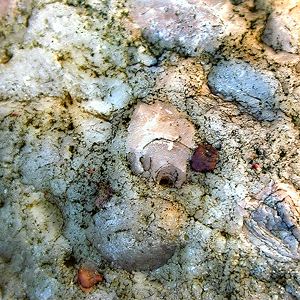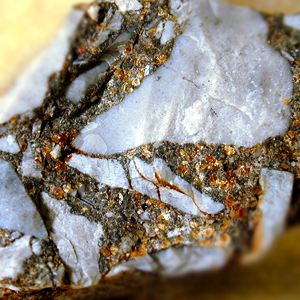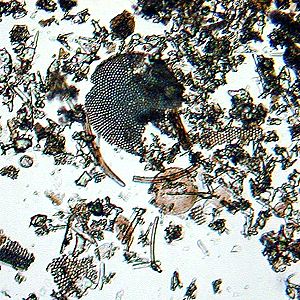Rhythmic Layers: this refers to the process where two types of sedimentary rock alternate back and forth down a bed. This is usually caused by a seasonal and somewhat drastic weather change that happens with regular frequency.
In high mountain environments, there is very slow sedimentation when a lake freezes over and the fine silt deposits in the winter. In the spring, there may be large granular sediments as the rivers feeding the lake deposit large material during energetic spring run off.
Cross Bedding: shows the method of layering from some type of turbulence in the original transport media. For instance, angled bedding at the edge of a lake, where wind and wave action may produce inclined bedding.
Graded Bedding: a bedding that is indicative of the method of transport. In this case the largest particle settle first, followed by the intermediate sizes and finally the very fine materials my take hours if not days to deposit. Well sorted materials. grading takes constant and continued movement over time.
Non-sorted sediment: caused by a catastrophic event. The material at the end of a glacier, a land slide, a slump... Some thing which happens relatively quickly and is not capable of continuous effect.


Chemical sedimentation requires the starting materials to be completely dissolved in a water solution. The water may then evaporate and by concentration of the constituents they reach chemical saturation and begin to precipitate. Or, there may be a change in the chemistry (often the pH - acid content) of the liquid which caused insolubility and precipitation.

Biogenic Sediment: in some case the sediment may be due to the death of small animals and the organic decomposition of their bodies. The remains may be small skeletons made up of calcium, silica, or phosphorus containing compounds. Diatoms are one such material.
Diatoms are the skeletons of many types of algae. They are made up of the hard body parts secreted by the algae. They are found in both lakes and oceans. They are a source of organic silica. They are used as filtering material in many processes.
Other ocean going creatures create calcite or aragonite shells (CaCO3) including algae and coral. These also may precipitate upon death of the creature and form oozes under the ocean. After further decomposition they produce calcium rich sediments.
Plants have been growing and dying for millions of years. When and if they are covered by overlaying rock they are protected from large quantities of oxygen which would otherwise break then down to H2O and CO2. This material can be compacted to form coal or oil. Both of these energy resources are sedimentary in nature. Although neither contains any minerals.
| NEXT | TOC | PREV |